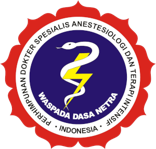Anaesthetic Management during Balloon Atrial Septostomy in Transposition of Great Arteries
Abstract
Discussion: A 1-day-old newborn girl was brought to Dr. Moewardi General Hospital in February 2022. The patient had a history of cyanosis when she cried and was born with an APGAR score of 6.7.8. The lips were cyanotic on physical examination, with a SpO2 of 77% with a nasal O2 of 2 lpm. The echocardiography results obtained TGA, ASD II, PFO, and PDA. The patient then underwent a BAS procedure. Anesthesia management was performed using ketamine for induction, air bar, O2, and sevoflurane for maintenance of anesthesia. The operation was successful, and postoperative care was carried out. Anesthesia management aims to keep SVR and PVR to a minimum, with a PVR lower than SVR, to prevent desaturation in the patient. A decrease in PVR also can increase pulmonary blood flow, allowing more blood to be mixed and higher oxygen saturation in the blood for the patient.
Conclusion: The principle of anesthesia management in TGA cases is to avoid a reduction in cardiac output and SVR and keep the PVR lower than the SVR.
Keywords
Full Text:
PDFReferences
- Nasr VG, DiNardo JA. The Pediatric Cardiac Anesthesia Handbook.
- Saikia D, Mahanta B. Cardiovascular and respiratory physiology in children. Vol. 63, Indian Journal of Anaesthesia. Wolters Kluwer Medknow Publications; 2019. p. 690–7.
- Al-Kassmy J, Navarro-Castellanos I, Barlatay FG, Miró J, Dahdah N. Balloon Atrial Septostomy: Does the Balloon Size Matter? CJC Pediatric and Congenital Heart Disease. 2022 Dec;1(6):253–9.
- Cheng DCH, Martin J, David T. Evidence-Based Practice in Perioperative Cardiac Anesthesia and Surgery.
- Natoli S. The multiple faces of ketamine in anesthesia and analgesia. Vol. 10, Drugs in Context. Bioexcel Publishing LTD; 2021.
- Mena Epiani NK, Gunawijaya E, Kartika Yantie NPV. Balloon atrial septostomy procedures for cyanotic congenital heart defect in Sanglah Hospital. Medicina (B Aires). 2019 Aug 1;50(2).
- Hines RL, Marschall KE. Stoelting’s ANESTHESIA AND CO-EXISTING DISEASE 7th Edition. 2018.
- Malek R, Soufi S. Pulmonary Edema [Internet]. [cited 2023 Mar 22]. Available from: https://www.ncbi.nlm.nih.gov/books/NBK557611/
- Akcay M, Kılıç E, Akdemir M. The comparison of the efficacy and safety of midazolam, ketamine, and midazolam combined with ketamine administered nasally for premedication in children. Anesth Essays Res. 2018;12(2):489.
- Midega TD, de Freitas Chaves RC, Ashihara C, Alencar RM, Queiroz VNF, Zelezoglo GR, et al. Ketamine use in critically ill patients: a narrative review. Vol. 34, Revista Brasileira de Terapia Intensiva. Associacao de Medicina Intensiva Brasileira - AMIB; 2022. p. 287–94.
- Dave NM. Premedication and induction of anesthesia in pediatric patients. Vol. 63, Indian Journal of Anaesthesia. Wolters Kluwer Medknow Publications; 2019. p. 713–20.
- Dhande K, Kshirsagar J, Dhande A, Patil N, V P. Hemodynamic Stability, Patient Acceptance and Cost of Intravenous Propofol and Inhalational Sevoflurane for Induction of Anaesthesia: A Prospective, Randomized Comparative Study. Cureus. 2020 Apr 16;
- Gupta S, Saiyed A, Meena R, Dogra N. Anaesthetic Management during Transposition of Great Arteries (TGA) Correction: Points to be Focussed. Br J Med Med Res. 2017 Jan 10;19(8):1–5.
- Brioni JD, Varughese S, Ahmed R, Bein B. A clinical review of inhalation anesthesia with sevoflurane: from early research to emerging topics. Vol. 31, Journal of Anesthesia. Springer Tokyo; 2017. p. 764–78.
- Moon TS, Smith KM. Ketamine Use in the Surgical Patient: a Literature Review. Curr Pain Headache Rep. 2021 Mar 25;25(3):17.
- Schwenk ES, Mariano ER. Designing the ideal perioperative pain management plan starts with multimodal analgesia. Vol. 71, Korean Journal of Anesthesiology. Korean Society of Anesthesiologists; 2018. p. 345–52.
Refbacks
- There are currently no refbacks.








